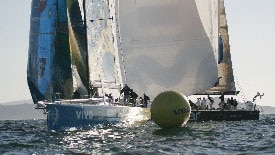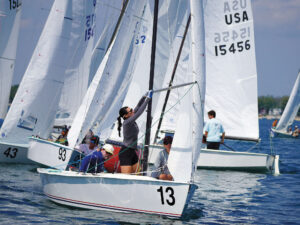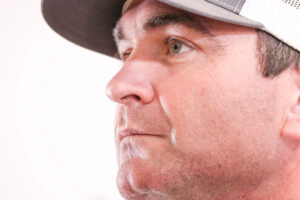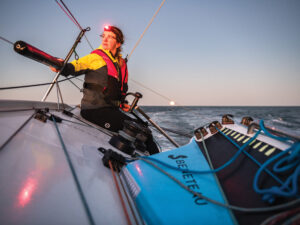
Brasil1 Mark Rounding
In-Port Showdown Confirms Speculation The 2005 edition of the Volvo Ocean Race got underway yesterday off the Spanish port of Sanxenxo, and while six of the seven teams had lined up alongside each other in some unofficial fashion while training here, this was the first real drag race-as much of a race as it could be in 5 knots of wind. All the weather experts knew the day was going to be an extreme light-air affair, and while two teams in particular preferred to postpone until the following day, Juan Carlos, the King of Spain, was the guest onboard the Spanish entry Movistar, and as this was his only day available, the race, no matter how slow it was, had to go off as planned. Six boats came to play, two boats from ABN AMRO, Brasil 1, Ericsson Racing, Movistar, and Pirates of the Caribbean. The Australian entry, Premiere Challenge, had just arrived from its delivery from Belgium, and opted to watch from the sidelines before taking the boat out to grind down its bulb in order to get the boat to within the weight limit. As I landed at the Vigo airport, 40 minutes south, of Sanxenxo, the starting sequence was already rolling, so no thanks to overbooked international flights, I missed what was described as a slow-paced, high-tension race; a race that demonstrated what was already know of this new fleet of Volvo 70s-that the ABN AMRO boats would suffer in light air and that Jason Carrington-built boats (Ericsson and Pirates) would be light and fast. The race, as described by ABN ..AMRO 2’s tactician Andrew Lewis was a “lemon of a racecourse. Ericcson won the left and one-tacked the first beat. At that point the race was over.” For the record, ABN’s weather team encouraged them to favor the right side of the racecourse and that they did, to no avail. As for Ericsson’s win and its 12-mile march to the top of the points board with 3.5 points: “We’re very happy,” navigator Steve Hayles told Volvo Ocean Race correspondent Andrew Rice in a post-race debrief. “It’s nice to see other boats cave in behind you, and to be able to sail away.” For John Kostecki, the team’s dedicated in-shore tactician, it played out like any other race. “Our weather guys were saying to stay away from the shore, and that the pressure would be on the left. We could see that there was better wind there and with our start we were able to do exactly what we wanted to. We were actually about two boatlengths off the line and Tim [Powell] was getting anxious, but I told him to calm down and look over his shoulder…everyone was late.” Kostecki says the wind dropped at the start, but as they continued left, they found more and more wind. “In that stuff, 1 knot more is huge.” As the official on-the-water correspondent, Rice had the best perspective and provided the following analysis on the Volvo Ocean Race website. +++++++++++++++++++++++++++++++++++++++++++++++++ As for revealing anything meaningful about relative speeds of the boats, he felt the race hadn’t been that conclusive. Ericsson’s race was won in the first five minutes, after a spot-on start off the left-hand of the line. “If you win the start, you look like you’ve got a fast boat, and that’s always the case,” said Hayles. Skipper Neal McDonald was delighted to have pulled off their pre-race game plan with such precision. “We wanted the left, and we won the left. We had the controlling hand. There wasn’t anything magical about our performance, other than getting a very good start. We shot out like a cork from a bottle, and in any one-design fleet it would have looked the same.” Ericsson’s weather team had suggested the left-hand side of the course looked better for breeze, and the brain’s trust on board the boat agreed, John Kostecki included. The winning skipper of the last Volvo Ocean Race certainly earned his fee today. “One down and six more of these In Port races to go,” said the American. “That was a good marker to put down.” One dilemma for the crews was how best to use that 11th man slot. Do you opt for extra brains or extra brawn? For much of this race, it looked like brains were the best bet, with the top three boats all having opted for a boost to the afterguard. Brasil 1 had the addition of ace Olympic talent Alan Adler, and America’s Cup skipper Pedro Campos took the helm of movistar. But then at the final turning mark, Pirates outmanoeuvred the Spaniards and stole their wind after a very smooth rounding and a slick hoist, enabling them to roll movistar and claim the final podium position. Perhaps the added muscle of America’s Cup grinder Mark McTeigue aboard Pirates wasn’t such a bad choice after all. The race brought very few hard and fast conclusions today, but it did call into question the value of the big Code 0 upwind genoas that made an appearance on a couple of boats today. ABN AMRO One started the race with such a sail tacked out to the end of her bowsprit, but she looked slower than the other five which had all opted for conventional jibs. This didn’t seem to deter movistar from hoisting one for the second beat. Having just got right on the tail of Brasil 1 after a poor leeward mark rounding by Torben Grael’s team, it looked like the Spanish might be able to break through into second place, much to the delight of the cheering spectator fleet. Grael had stayed with his jib, so it would be interesting to see if movistar’s change of sail would pull them through. But the Brazilians dived off left after Ericsson, and both these boats again found good breeze to extend on the boats behind. Pirates rounded in fourth and immediately tacked off left, with the Spaniards yet to tack. When these two boats converged again, it was now on level terms and Bouwe Bekking’s decision to stay right had conceded a three minute lead to Cayard in a very short time. A drag race then ensued, an opportunity for these teams to gauge who had made the better choice of sail. There was very little in it, perhaps just a slight edge to the Pirates. But the real key came at that top mark. While the extra size of the Code 0 and it’s position not far forward of the forestay means that it must be furled before the tack and unfurled after the tack is complete, the smaller and simpler jib allows a much smoother and faster manoeuvre. As movistar reached the mark and embarked on the cumbersome furl/unfurl process, Pirates sliced through their tack in half the time, and maintained much better momentum around the mark. Even though the Spanish were much faster to hoist their asymmetric, Cayard steered The Black Pearl into an attacking position before hoisting. Two minutes later the Pirates had plundered the Spanish wind supply and they rolled past them. For Cayard this was a key moment. “I knew some of the guys had some specialty sails measured in. I was fine with that, I chose not to have any specialty sails measured in, because sail cards are very precious. There are only 24 of them, and we’ve only measured in eight sails, where other guys have already measured in 14. It was very good to observe the work they’ve done, and now we’ll go to school on that and figure out how we want to spend our cards. “We have a Code 0, we have a couple of them in fact, but I’m not sure they’re quite right yet. So I accepted that we wouldn’t use any specialty sails in this race, and even if someone else used something different and it was a little painful for us, we’d live with it, and also they’d be showing me that something better.” As it was, neither movistar nor ABN AMRO One displayed exceptional pace with their Code 0 upwind sails. Have they burned up one of their 24 cards already? Mike Sanderson put a brave face on a woeful performance by the best-funded boat in the fleet. In the preceding days he had made it clear that we shouldn’t expect a sparkling performance in light airs. ABN AMRO One is a fat-bottomed girl who likes a good breeze to allow her to strut her stuff. She doesn’t like it light and fluffy. “I can walk down the dock and I can show you the narrowest boat and I can show you the widest one,” said Moose. “It wasn’t the biggest surprise. We always knew that a six-knot In Port race – where we got the start wrong – would be our biggest nightmare. I think I’ve said that publicly before. You know that when you put your boat at one side of a fleet, you’re going to come first sometimes and other times you’re going to come last. We’re still adamant we’ve the right boat for the race. I don’t think we’ll be having this conversation in Cape Town.” For today, the race village remains crowded as crews take a break and debrief in preparation for the move to Vigo next weekend. Check back here regularly as I’ll be bringing slices of life behind the scenes in the lead-up to the November 12 start.









